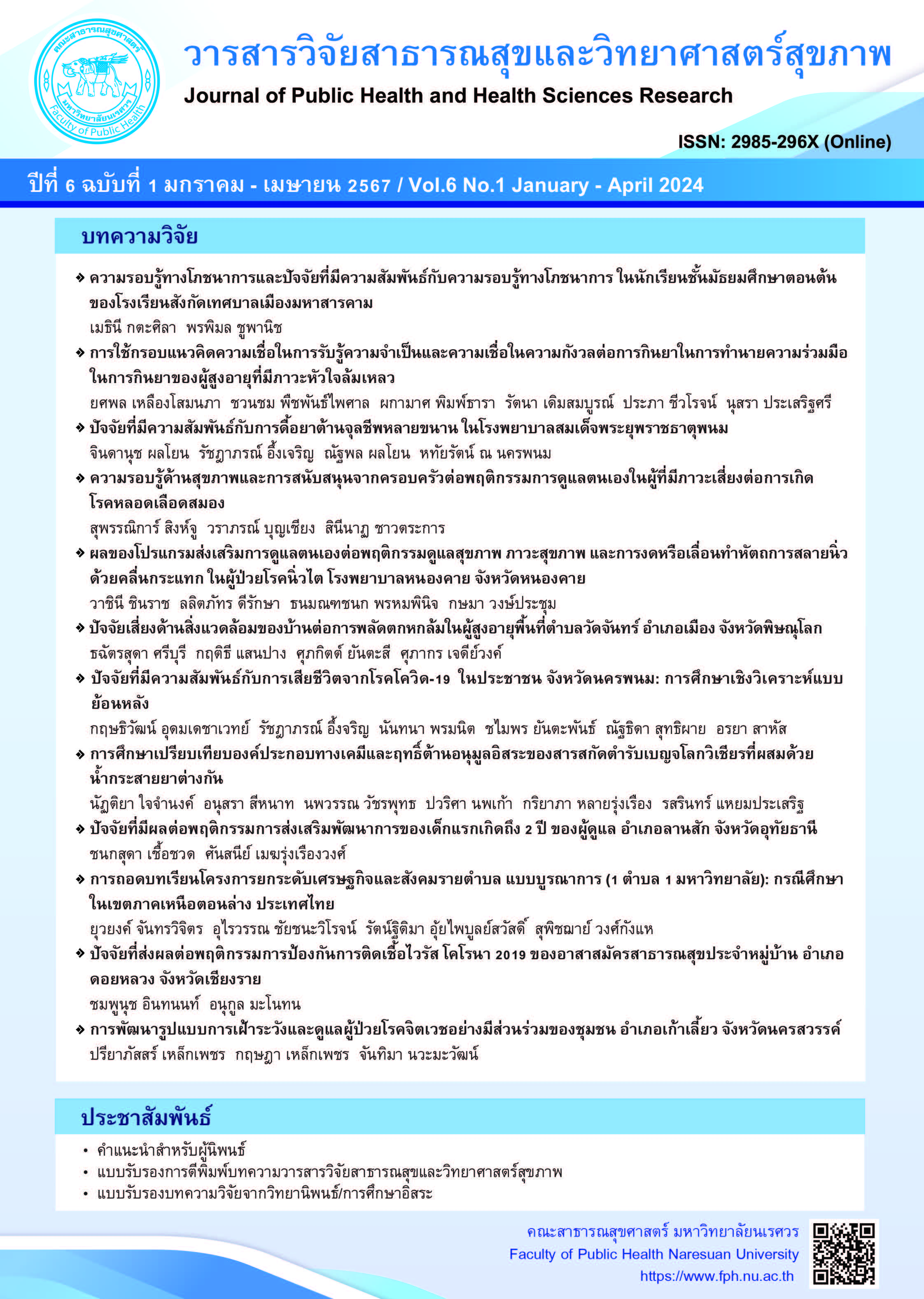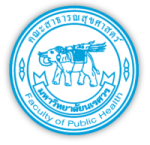ปัจจัยที่มีความสัมพันธ์กับการดื้อยาต้านจุลชีพหลายขนาน ในโรงพยาบาลสมเด็จพระยุพราชธาตุพนม
คำสำคัญ:
ดื้อยาต้านจุลชีพหลายขนาน, ปัจจัยเสี่ยง, โรงพยาบาลชุมชนบทคัดย่อ
การดื้อยาต้านจุลชีพหลายขนาน เป็นปัญหาด้านสาธารณสุขที่ยังเป็นปัญหาสำคัญในปัจจุบัน การศึกษาย้อนหลังแบบกลุ่มศึกษาและกลุ่มควบคุมครั้งนี้ มีวัตถุประสงค์เพื่อศึกษาปัจจัยที่มีความสัมพันธ์กับการดื้อยาต้านจุลชีพหลายขนานของเชื้อแบคทีเรียในผู้ป่วยที่เข้านอนโรงพยาบาล ในโรงพยาบาลสมเด็จพระยุพราชธาตุพนมระหว่างวันที่ 1 มกราคม พ.ศ. 2559 ถึง 31 ธันวาคม พ.ศ. 2563 วิเคราะห์ปัจจัยที่มีผลต่อการดื้อยาต้านจุลชีพโดยใช้การวิเคราะห์แบบ Binary logistic regression
ผลการศึกษาพบผู้ป่วยดื้อยาต้านจุลชีพหลายขนานร้อยละ 28.3 ของผู้ป่วยที่ศึกษาทั้งหมด พบมากในผู้ป่วยที่อายุมากกว่า 60 ปี เชื้อดื้อยาหลายขนานที่พบมากที่สุด คือ เชื้อ Escherichia coli ปัจจัยเสี่ยงต่อการดื้อยาต้านจุลชีพหลายขนานคือ มีประวัติสูบบุหรี่ (ORAdj= 1.38, 95% CI = 1.08-1.74) มีประวัติดื่มแอลกอฮอล์ (ORAdj= 1.27, 95% CI = 1.02-1.58) การติดเชื้อที่ระบบทางเดินปัสสาวะ (ORAdj= 2.84, 95% CI = 2.19-3.67) การติดเชื้อแบคทีเรียแกรมลบ (ORAdj= 2.99, 95% CI = 2.28-3.91) การมีประวัติใช้ยาสเตียรอยด์ใน 90 วัน (ORAdj= 1.87, 95% CI = 1.40-2.51) การมีประวัติเคยใช้สายสวนปัสสาวะภายใน 90 วัน (ORAdj= 1.64, 95% CI = 1.25-2.17) ระยะเวลานอนโรงพยาบาลมากกว่า 7 วัน (ORAdj= 1.44, 95% CI = 1.16-1.81) ดังนั้น โรงพยาบาลควรนำปัจจัยที่ได้จากการศึกษาครั้งนี้มากำหนดนโยบายและแนวทางป้องกันการดื้อยาต้านจุลชีพหลายขนานเพื่อควบคุมการติดเชื้อและลดการแพร่กระจายเชื้อดื้อยาต้านจุลชีพหลายขนานอย่างมีประสิทธิภาพมากขึ้น
References
Abdelmalek, S. M. A., Alhadad, S., Abu-Omar, O., Afaneh, M., Abu-Qatouseh, L., & Collier, P. J. (2022). The effect of cigarette smoke condensate (CSC) on Pseudomonas aeruginosa virulence and antibiotic sensitivity. Journal of applied microbiology, 132(5), 3951-3958. https://doi.org/10.1111/jam.15501
Amanati, A., Sajedianfard, S., Khajeh, S., Ghasempour, S., Mehrangiz, S., Nematolahi, S., & Shahhosein, Z. (2021). Bloodstream infections in adult patients with malignancy, epidemiology, microbiology, and risk factors associated with mortality and multi-drug resistance. BMC infectious diseases, 21(1), 636. https://doi:10.1186/s12879-021-06243-z
Antimicrobial Resistance Collaborators. (2022). Global burden of bacterial antimicrobial resistance in 2019: a systematic analysis. Lancet (London, England), 399(10325), 629–655. https://doi.org/10.1016/S0140-6736(21)02724-0
Boonlum, S. (2021). Risk Factors of the Multidrugresistant in Surgical II Intensive Care Unit, Suratthani Hospital. Journal of Health Sciences and Pedagogy, 1(1), 28-39. (in Thai)
Centers for Disease Control Prevention. (2019, December). Antibiotic resistance threats in the United States, 2019. Retrieved December 20, 2021, from www.cdc.gov/DrugResistance/Biggest-Threats.html
Chara, C., Khemla, S., Pholhemhan, S., Surin, U., & Prasert, K. (2016). Risk factors associated with antibiotic multidrug resistant nosocomial infection among hospitalized patients aged 14 years and older in Nakhon Phanom Hospital. Nakhon Phanom Hosp J, 6(1), 6-17. (in Thai)
Chomjan, T., & Singto, P. (2022). Multipleantimicrobial resistance (AMR) of patients in internal dedicine department. APHEIT Journal of Nursing and Health, 4(3), 1-16. (in Thai)
Chomkerd, T., Phanpanich, W., & Menaphol, S. (2019). Histological alterations of the urinary tract infection by Escherichia coli from urinary catheter. Srinagarind Medical Journal, 34(4), 406-413. (in Thai)
Chopjitt, P., Putthanachote, N., Sangsa, N., Sirisa, P., Chinnakarnsawas, S., Kankang, C., et al. (2021). Factors associated with multidrugresistant Pseudomonas aeruginosa infection: a hospital-based case-control study. Archives of Allied Health Sciences, 33(2), 48-55.
Chungsamanukool, P. (2022). Incidence, risk factors, mortality rate, and impact of multidrugresistant gram-negative bloodstream Infections in Photharam hospital. Region 4-5 Medical Journal 41(1), 579-592. (in Thai)
Clinical and Laboratory Standards Institute. (2021). Performance standards for antimicrobial susceptibility testing (31st ed.): CLSI supplement M100. Clinical and Laboratory Standards Institute.
Dessie, T., Jemal, M., Maru, M., & Tiruneh, M. (2021). Multiresistant bacterial pathogens causing bacterial pneumonia and analyses of potential risk factors from northeast Ethiopia. International Journal of Microbiology, 2021, 6680343. https://doi: 10.1155/2021/6680343
Falcone, M., Tiseo, G., Dentali, F., La Regina, M., Foglia, E., Gambacorta, M., et al. (2018). Predicting resistant etiology in hospitalized patients with blood cultures positive for Gram-negative bacilli. European journal of internal medicine, 53, 21-28. https://doi:10.1016/j.ejim.2018.01.029
Gomila, A., Shaw, E., Carratala, J., Leibovici, L., Tebe, C., Wiegand, I., et al. (2018). Predictive factors for multidrug-resistant gram-negative bacteria among hospitalised patients with complicated urinary tract infections. Antimicrob Resist Infect Control, 7, 111: https://doi: 10.1186/s13756-018-0401-6
Health Systems Research Institute Coordination and Integration Committee on Antimicrobial Resistance. (2017, December). Thailand national strategic plan on antimicrobial resistance 2017-2021 [online]. Retrieved April 15, 2023, from https://rr-asia.woah.org/wp-content/uploads/2020/03/thailand_thailands-national-strategic-plan-on-amr-2017-2021.pdf (in Thai)
Juylek, N., Picheansathian, W., & Kasatpibal, N. (2016). Development of risk factor scoring system of multidrug-resistant microorganism infection among in-patients. Nursing Journal CMU, 43(3), 69-80. (in Thai)
Kakoullis, L., Papachristodoulou, E., Chra, P., & Panos, G. (2021). Mechanisms of antibiotic resistance in important gram-positive and gram-negative pathogens and novel antibiotic solutions. Antibiotics, 10(4), 415.
Laboratory Department Thatphanom Crown Prince Hospital. (2020). Annual examination report.Nakhon Phnom: Thatphanom Crown Prince Hospital. (in Thai)
Nakhonphanom Provincial Health Office. (2019). Annual report on antimicrobial susceptibility results in Nakhon Phanom Province. Nakhon Phnom: Nakhonphanom Provincial Health Office. (in Thai)
Nakhonphanom Provincial Health Office. (2021, September 30). Summary of problems from the inspection and recommendations of a grocery store selling health products in Nakhon Phanom Province in 2021. Retrieved April 20, 2023, from https://www.nkp-ossc.net (in Thai)
Nakonchai, T. (2018). Factors associated with multi drug resistant infections among patients of Udonthani cancer hospital. Nursing, Health, and Education Journal, 1(1), 23-30. (in Thai)
National Antimicrobial Resistance Surveillance Thailand. (2019). Global and national antimicrobial resistance situation 2019. Retrieved December 20, 2021, from http://narst.dmsc.moph.go.th/
Phodha, T., Riewpaiboon, A., Malathum, K., & Coyte, P. C. (2019). Excess annual economic burdens from nosocomial infections caused by multi-drug resistant bacteria in Thailand. Expert Rev Pharmacoecon Outcomes Res, 19(3), 305-312. https://doi:10.1080/14737167.2019.1537123
Ponyon, J., Kerdsin, A., Preeprem, T., & Ungcharoen, R. (2022). Risk factors of infections due to multidrug-resistant gram-negative bacteria in a community hospital in rural Thailand. Tropical Medicine and Infectious Disease, 7(11). https://doi:10.3390/tropicalmed7110328
Ponyon, J., & Ungcharoen, R. (2023). Incidence of multidrug-resistant gram-negative bacteria in blood specimens in a community hospital in northeast. Thai Journal of Pharmacy Practice, 15(1), 96-109. (in Thai)
Punchuey, S. (2023). Do the benefits of systemic corticosteroids outweigh adverse effects. Krabi Medical Journal, 5(2), 71-91. (in Thai)
Rafailidis, P. I., & Kofteridis, D. (2022). Proposed amendments regarding the definitions of multidrug-resistant and extensively drug-resistant bacteria. Expert Review of Anti-infective Therapy, 20(2), 139-146. https:// doi:10.1080/14787210.2021.1945922
Ruayajin, N., Chomjan, T., & Singto, P. (2022). The outcomes of using anti-AMR guideline to prevent the spread of drug-resistant organisms infections. Singburi Hospital Journal, 31(1), 27-40. (in Thai)
Thai health codig center. (2015, May 29). Number of hospitals classified by type (public and private). Retrieved December 20, 2021, fromhttp://thcc.or.th/download/Number%20of%20hospital%20290558.pdf
Thammatacharee N., Tomacha N., & Pannarunothai S. (2022). Advocacy on rational drug use policy in Thailand. Journal of Health Systems Research,16(3), 281-288. (in Thai)
Viasus, D., Puerta-Alcalde, P., Cardozo, C., Suarez- Lledo, M., Rodriguez-Nunez, O., Morata, L., et al. (2020). Predictors of multidrug-resistant Pseudomonas aeruginosa in neutropenic patients with bloodstream infection. Clinical Microbiology and Infection, 26(3), 345-350. https://doi:10.1016/j.cmi.2019.07.002
Yingkhajorn, S., Sutthichot, S., Hongthong, N., Boonrod, T., Simla, W., & Sriraksa, S. (2021). Occurrence of antimicrobial resistance in hospital: A systematic review and meta-analysis. Journal of Health Science, 30(5), 916-927.
Downloads
เผยแพร่แล้ว
How to Cite
ฉบับ
บท
License
Copyright (c) 2024 วารสารวิจัยสาธารณสุขและวิทยาศาสตร์สุขภาพ

This work is licensed under a Creative Commons Attribution-NonCommercial-NoDerivatives 4.0 International License.
บทความที่ได้รับการตีพิมพ์เป็นลิขสิทธิ์ของวารสารวิจัยสาธารณสุขและวิทยาศาสตร์สุขภาพ
ข้อความที่ปรากฏในบทความแต่ละเรื่องบทความในวารสารวิชาการและวิจัยเล่มนี้เป็นความคิดเห็นส่วนตัวของผู้เขียนแต่ละท่านไม่เกี่ยวข้องกับมหาวิทยาลัยนเรศวร และคณาจารย์ท่านอื่นๆในมหาวิทยาลัยฯ ความรับผิดชอบเกี่ยวกับบทความแต่ละเรื่องผู้เขียนจะรับผิดชอบของตนเองแต่ละท่าน






